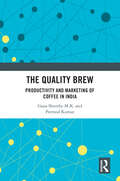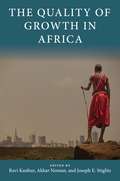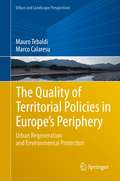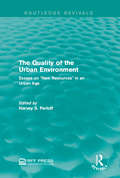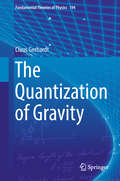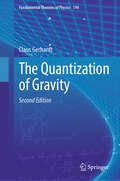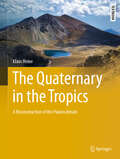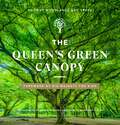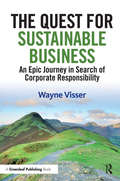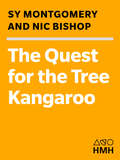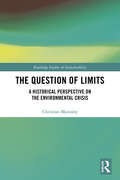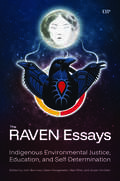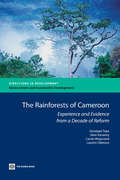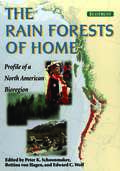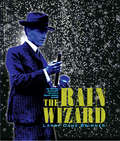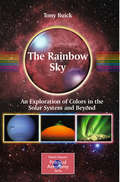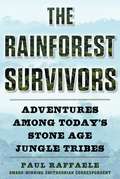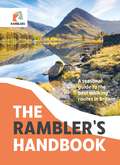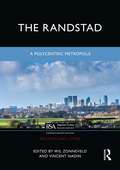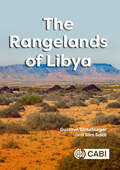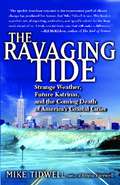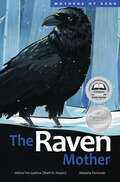- Table View
- List View
The Pythagorean World
by Jane McdonnellThis book explores precisely how mathematics allows us to model and predict the behaviour of physical systems, to an amazing degree of accuracy. One of the oldest explanations for this is that, in some profound way, the structure of the world is mathematical. The ancient Pythagoreans stated that "everything is number". However, while exploring the Pythagorean method, this book chooses to add a second principle of the universe: the mind. This work defends the proposition that mind and mathematical structure are the grounds of reality.
The Quality Brew: Productivity and Marketing of Coffee in India
by Parmod Kumar Gana Shruthy M.K.Coffee is a major commodity of export in developing countries. In India, it generates significant revenues besides providing employment to many. This book critically looks into various aspects of the coffee production and marketing industry and its potential for promoting sustainable development, poverty alleviation and providing decent work.The small-holder dominated coffee sector is under unprecedented crisis attributed to a host of factors like declining productivity, incidences of new pests and diseases, adverse price trends and issues related to global warming induced climate change. Supported with primary survey and secondary data, this book explores challenges related to coffee production and its economic importance in India. It analyses factors affecting productivity of Robusta and Arabica varieties of coffee— and offers important inferences about the relationship between age and productivity of the plants and factors that guarantee high productivity. The book also sheds light on institutional interventions and the use of IT applications, along with online trading, in the coffee sector.Comprehensive and insightful, the book will be of interest to students and researchers of agriculture studies, agricultural economics, horticulture with a special focus on spices and plantation, sustainability studies, development studies and crop science. It will also be useful to stakeholders of plantation crops, such as, growers, as well as policy makers, processors, traders and exporters at different levels.
The Quality of Growth in Africa (Initiative for Policy Dialogue at Columbia: Challenges in Development and Globalization)
by Joseph E. Stiglitz Ravi Kanbur Akbar NomanIn recent years, concerns about the outcomes and nature of economic growth have given way to a new emphasis on its quality. This volume brings together prominent international contributors to consider a range of interrelated questions concerning the quality of growth in Africa, with a primary focus on sub-Saharan countries.Contributors discuss the measurement of growth, the transformations necessary to sustain it, and issues around equity and well-being. They consider topics such as the distribution of income gains from growth; the extent to which economic growth has resulted in improvements in employment, poverty, and security; structural transformations of the economy and diversification of the sources of growth; environmental sustainability; and management of urbanization. Offering both diagnoses and prescriptions, The Quality of Growth in Africa helps envision a future that goes beyond increasing GDP to ensuring that growth translates into advancements in well-being. Although the book focuses on sub-Saharan Africa, much of the contributors’ incisive analysis has implications for countries outside the region.
The Quality of Territorial Policies in Europe’s Periphery: Urban Regeneration and Environmental Protection (Urban and Landscape Perspectives #22)
by Mauro Tebaldi Marco CalaresuThis book focuses on territorial policies as instruments for local development in Europe’s periphery. Using a multiple-case research design in three typical case studies in the context of the Mediterranean island of Sardinia (Italy), we empirically test the hypothesis that the institutionalisation of the governance system is an independent variable that is capable of influencing the quality of public policy, intended as a dependent variable. According to this hypothesis, the two above-mentioned variables tend to change according to a linear and direct correlation: upward variation of the degree of institutionalisation of the governance system tends to correspond to upward variation in the quality of the policy, and vice versa. In our conclusions, we discuss the descriptive and prescriptive implications of the empirical findings of the research for the local development of peripheral areas. Regarding the descriptive implications, we explain how territorial policy-making can be articulated, based on the degree of institutionalisation of the governance system and the quality of the territorial policies. Regarding the prescriptive implications, we identify the best practices for territorial governance in order to improve the chances of local development in Europe’s periphery.
The Quality of the Urban Environment: Essays on "New Resources" in an Urban Age (Routledge Revivals)
by Harvey S. PerloffThe quality of the environment in which people live, work, and play influences to no small degree the quality of life itself. The environment can be satisfying and attractive and provide scope for individual development or it can be poisonous, irritating and stunting. The papers in this volume, first published in 1969, are concerned with the urban environment – in which the majority of Americans live – or, more accurately, with the environment of urbanites, for the concern extends to outlying areas where urban dwellers visit and play. The chapters aim to provide a better understanding of the natural resource elements in the urban environment, and will be of interest to students of environmental studies and human geography.
The Quantization of Gravity (Fundamental Theories of Physics #194)
by Claus GerhardtA unified quantum theory incorporating the four fundamental forces of nature is one of the major open problems in physics. The Standard Model combines electro-magnetism, the strong force and the weak force, but ignores gravity. The quantization of gravity is therefore a necessary first step to achieve a unified quantum theory. In this monograph a canonical quantization of gravity has been achieved by quantizing a geometric evolution equation resulting in a gravitational wave equation in a globally hyperbolic spacetime. Applying the technique of separation of variables we obtain eigenvalue problems for temporal and spatial self-adjoint operators where the temporal operator has a pure point spectrum with eigenvalues $\lambda_i$ and related eigenfunctions, while, for the spatial operator, it is possible to find corresponding eigendistributions for each of the eigenvalues $\lambda_i$, if the Cauchy hypersurface is asymptotically Euclidean or if the quantized spacetime is a black hole with a negative cosmological constant. The hyperbolic equation then has a sequence of smooth solutions which are products of temporal eigenfunctions and spatial eigendistributions. Due to this "spectral resolution" of the wave equation quantum statistics can also be applied to the quantized systems. These quantum statistical results could help to explain the nature of dark matter and dark energy.
The Quantization of Gravity (Fundamental Theories of Physics #194)
by Claus GerhardtA unified quantum theory incorporating the four fundamental forces of nature is one of the major open problems in physics. The Standard Model combines electro-magnetism, the strong force and the weak force, but ignores gravity. The quantization of gravity is therefore a necessary first step to achieve a unified quantum theory. In this monograph a canonical quantization of gravity has been achieved by quantizing a geometric evolution equation resulting in a hyperbolic equation in a fiber bundle, where the base space represents a Cauchy hypersurface of the quantized spacetime and the fibers the Riemannian metrics in the base space. The hyperbolic operator, a second order partial differential operator, acts both in the fibers as well as in the base space. In this second edition new results are presented which allow the solutions of the hyperbolic equation to be expressed as products of spatial and temporal eigenfunctions of self-adjoint operators. These eigenfunctions form complete bases in appropriate Hilbert spaces. The eigenfunctions depending on the fiber elements are a subset of the Fourier kernel of the symmetric space SL(n,R)/SO(n), where n is the dimension of the base space; they represent the elementary gravitons corresponding to the degrees of freedom in choosing the entries of Riemannian metrics with determinants equal to one. These are all the degrees of freedom available because of the coordinate system invariance: For any smooth Riemannian metric there exists an atlas such that in each chart the determinant of the metric is equal to one. In the important case n=3 the Standard Model could also be incorporated such that one can speak of a unified quantization of all four fundamental forces of nature.
The Quaternary in the Tropics: A Reconstruction of the Palaeoclimate (Springer Textbooks in Earth Sciences, Geography and Environment)
by Klaus HeineThe Ice Age (Quaternary) is a period of extreme climate fluctuations that led to the growth and melting of massive ice sheets in the high latitudes. Tropical deserts, savannas, rainforests, and mountainous regions experienced equal dramatic climatic changes of which the traces are preserved in sedimentary deposits. The knowledge of tropical climate history is of paramount importance because in the tropics and marginal tropics, natural and - more recently - human-induced processes significantly control global climate. Yet relatively few palaeoclimate records are known from these regions.This book presents the climate archives of the tropics and critically discusses their palaeoclimatic informative value. Based on decades of research the author demonstrates that a lack of geoecological knowledge leads to misinterpretations in modeling climate futures. The results presented here call for a correction of many widely held views about the role of atmospheric greenhouse gases in global warming over the past 150 years.The book is intended for natural scientists of all disciplines who are looking for a synopsis of the problem area "Our climate in the past, present and future in the tropics".
The Queen's Green Canopy: Ancient Woodlands and Trees
by Adrian Houston Charles Sainsbury-PlaiceStunning photographs of the United Kingdom's most spectacular trees - with a foreword by His Majesty the King.The Queen's Green Canopy is a beautiful photography book showcasing 70 ancient trees and 70 ancient woodlands dedicated by the QGC initiative in honour of Her Majesty's Platinum Jubilee.The book features extraordinary photographs of the United Kingdom's best-loved trees, many of which inspired historic figures, artists and writers through the centuries.Alongside these photographs are short written pieces from contributors including Dame Judi Dench, Alan Titchmarsh, Dame Joanna Lumley, Adam Henson, Archbishop Justin Welby and Danny Clarke, as well as conservation experts from the Woodland Trust and the Duchy of Cornwall. In these pieces they reflect on the trees that have made a mark on their lives and the importance of protecting Britain's woodlands for future generations.Selected trees include yews at a Cotswold's church which inspired JRR Tolkien; the apple tree believed to have inspired Sir Isaac Newton's theory of gravity; the Five Hundred Acre Wood in East Sussex immortalised in AA Milne's Winnie the Pooh books; and the 2,500-year-old tree where Henry VIII may have proposed to Anne Boleyn.So far 3 million trees have been planted by communities, schools and businesses across the country as part of the QGC initiative. Through incredible imagery and joyful pieces of writing, The Queen's Green Canopy celebrates Her Majesty's extraordinary life and the amazing legacy she leaves behind.
The Quest for Sustainable Business: An Epic Journey in Search of Corporate Responsibility
by Wayne VisserIn January 2010, author, academic and social entrepreneur Dr Wayne Visser set off on a nine-month, 20-country "quest" to talk to entrepreneurs, business leaders and innovators and learn about how companies in all parts of the world can and are helping to tackle the world's most pressing social and environmental problems. His aim was to explore the many varieties of global approaches to sustainable business practices first-hand and to share some of the most innovative global examples.The result is this treasure trove of a book, full of stories, ideas, links to more than 100 video interviews, best practices and tools for making sustainable business work in a myriad of different contexts, cultures and settings. Besides sharing insights from his 2010 "CSR Quest World Tour", the author captures his professional experiences and the evolution of sustainable business over the past 20 years.The path begins in Africa and winds its way through Asia, North America, Europe, Australasia and Latin America. The author shares what he has learned in encounters with mega-corporations and small farmers, and conversations with CEOs and social entrepreneurs. There are facts and figures about world trends, and interviews with thought leaders and activists. This is a tale that consciously weaves the personal and the professional, mixing anecdotes and case studies. It looks outwards and reflects inwards, and is both autobiography and the life story of a global movement.
The Quest for the Tree Kangaroo: An Expedition to the Cloud Forest of New Guinea (Scientists in the Field Series)
by Sy Montgomery Nic Bishop<P>It looks like a bear, but isn't one. It climbs trees as easily as a monkey- but isn't a monkey, either. It has a belly pocket like a kangaroo, but what's a kangaroo doing up a tree? Meet the amazing Matschie's tree kangaroo, who makes its home in the ancient trees of Papua New Guinea's cloud forest. And meet the amazing scientists who track these elusive animals. <P>[This text is listed as an example that meets Common Core Standards in English language arts in grades 4-5 at http://www.corestandards.org.] <P><P> Winner of the Sibert Honor
The Question of Limits: A Historical Perspective on the Environmental Crisis (Routledge Studies in Sustainability)
by Christian MaroubyWe have forgotten how to think about limits. Most philosophical approaches to the environment have focused primarily on the value of the natural world, the status of anthropocentrism and the Anthropocene, and the largely ethical questions of our impact on the world. While fully acknowledging these concerns, this book emphasizes the centrality of the confrontation between the imperative of growth that has been present since the Enlightenment and our belated rediscovery of limits. The expression "Limits to Growth", the title of a famous book from 1972 by Donella H. Meadows et al., may have passed into a common discourse, yet the notion of limits itself remains insufficiently theorized, or even reflected upon, in the current movement of environmental advocacy. Sometimes it even seems as if there is an effort to avoid it. This book argues that, on the contrary, we can only resolve the present global challenges by confronting the question of limits and making it central to our reflection. This entails discussing the long history of thinking about limits in which Malthus is the most infamous figure, but which also includes such major participants as John Stuart Mill and Karl Marx. Ultimately, The Question of Limits contends that the value of embracing limits extends beyond the environment and offers the potential to become a transformative social good. The Question of Limits will be of great interest to students and scholars working at the intersection of environmental studies, economics, intellectual history and philosophy.
The RAVEN Essays: Indigenous Environmental Justice, Education, and Self-Determination
by John Borrows Susan Smitten Max Ritts Dawn HoogeveenNamed after the Respecting Aboriginal Values and Environmental Needs (RAVEN) nonprofit organization, The RAVEN Essays is an anthology that celebrates a decade of prize-winning student essays. Since 2012, RAVEN has awarded an annual essay prize to honour students who champion the vital importance of Indigenous rights and self-determination, both in Canada and globally. The essays featured in this collection highlight exceptional student work while reflecting on the evolving relationship between Indigenous politics and academia. From issues like fishing rights and the Trans Mountain Pipeline to challenges of sexism and conservation policy, these essays capture a transformative period in Indigenous struggles, offering insights that resonate far beyond the Canadian settler state.The anthology also includes contributions from prominent scholars such as Glen Coulthard, Dara Culhane, Michael Fabris, Sarah Hunt, and Heather Dorries. Five complementary essays explore various aspects of structural change, institutional constraints, and broader commitments to Indigenous knowledge within university settings. Aimed at readers in Indigenous law, environmental studies, anthropology, and geography, The RAVEN Essays is a book created by students for students, and by academics for the academy. Together, the contributors reflect on the powerful formation and enactment of Indigenous law, environmental stewardship, place-based knowledge, pedagogy, and literacy – both within the academy and in the broader community, across land, water, and culture.
The Rain Forests of Cameroon: Experience and Evidence from a Decade of Reform
by Carole Megevand Giuseppe Topa Laurent Debroux Alain KarsentyStarting in 1994, Cameroon introduced regulatory and market-based reforms to regulate access to its rainforests, balance public and private interests in those forests, and integrate wider economic, cultural, and environmental perspectives of the value of forests. Based on historical data and extensive interviews, this report concludes that the reforms brought order over the most aggressively competing interests and started to address deeper social and environmental issues, but a significant unfinished agenda remains. On the positive side, information on the boundaries, ownership, use rights, and management of Cameroon's rainforests has become available for public scrutiny, along with information on detection and prosecution of illegal activities. Better and better known rules of the game have improved forest governance and collaboration between forest institutions and civil society. More than 60 percent of Cameroon's rainforests are under management systems that emphasize sustainability. Illegal logging has declined sharply managed parks and production forests, although it persists in rural areas. The restructured forest industry has adopted internationally recognized management practices that have started to align logging with the forest's capacity to regenerate. Cameroon has established rules to preserve customary rights to forests, and community forests have progressed despite unanticipated challenges. Yet further reform is needed. Deeper recognition of the customary rights of all people who depend on Cameroon's forests, regardless of ethnicity, is vital. Timber and nontimber forest products like medicinal plants and bush meat remain subject to illegal exploitation outside state forests. Cameroon needs qualified eco-investors to sustain conservation and diminish reliance on timber production. Community involvement in the management of all types of forests should expand further. Great attention to local markets and small firms will strengthen forest governance and the forest industry in important ways. Rewarding responsible corporate behavior with more lenient bank guarantees and tax incentives may prove as important for conserving forests as punishing corporate misbehavior.
The Rain Forests of Home: Profile Of A North American Bioregion
by Jerry F. Franklin Patricia Marchak Peter Schoonmaker Edward C. Wolf Bettina Von HagenStretching from the redwoods of California to the vast stands of spruce and hemlock in southeast Alaska, coastal temperate rain forests have been home to one of the highest densities of human settlements on the continent for thousands of years. However, the well-being of this region is increasingly threatened by diminishing natural capital, declining employment in traditional resource-based industries, and outward migration of young people to cities.The Rain Forests of Home brings together a diverse array of thinkers -- conservationists, community organizers, botanists, anthropologists, zoologists, Native Americans, ecologists, and others -- to present a multilayered, multidimensional portrait of the coastal temperate rain forest and its people. Joining natural and social science perspectives, the book provides readers with a valuable understanding of the region's natural and human history, along with a vision of its future and strategies for realizing that vision.Authors describe the physical setting and examine the geographic and evolutionary forces that have shaped the region since the last glacial period, with individual chapters covering oceanography, climate, geologic processes, vegetation, fauna, streams and rivers, and terrestrial/marine interactions. Three chapters cover the history of human habitation, and the book concludes with an exploration of recent economic, political, and cultural trends.Interspersed among the chapters are compelling profiles of community-level initiatives and programs aimed at restoring damaged ecosystems, promoting sustainable use of resources, and fostering community-based economic development. The Rain Forests of Home offers for the first time a unified description of the characteristics, history, culture, economy, and ecology of the coastal temperate rain forest. It is essential reading for anyone who lives in or cares about the region.
The Rain Wizard: The Amazing, Mysterious, True Life of Charles Mallory Hatfield
by Larry Dane BrimnerIn December 1915, San Diego's leaders claimed the town's reservoirs were nearly dry. Knowing the city would not survive and grow unless it had water, they hired Charles Mallory Hatfield, whose skills at making rain were legendary. But when torrents and torrents of rain came, disaster struck. Roads were closed, people drowned, and dams burst. The town elders blamed Hatfield and refused to pay him. Was Hatfield really a rain wizard, or simply a fraud? Renowned author Larry Dane Brimner examines the man and the myth by relying on personal recollections from growing up in California, as well as extensive research. Readers will be captivated by Hatfield--a man once known as the Frankenstein of the air--and his secret rainmaking formulas. Includes author's note, source notes, and bibliography.
The Rainbow Sky
by Tony BuickThere are many more astronomical and meteorological phenomena involving color than most people are aware of, let alone have observed. Visual double stars with contrasting color are obvious targets for amateur astronomers, but there are many more - everything from colors on the Moon, through colors on the planets and in deep-sky objects, to man-made colors in the night sky. A great deal of these colored phenomena can be seen with the unaided eye, and can be visible in - and imaged with - a modest telescope, but all require preparation, anticipation and planning. The result will be some breathtaking sights, along with some amazing images. Just browsing through this book will captivate the reader. Some events are familiar but present severe challenges to photograph. Some can be captured only by using previously unfamiliar techniques. And it is almost certain that some will never have been seen before by readers. All the colored objects and phenomena are accessible by using the right techniques, for which Tony Buick provides easy-to-follow instructions.
The Rainforest Book (Conservation for Kids)
by Charlotte MilnerEmbark on a journey through the magical world of the rainforest and introduce little nature-lovers to an enchanting, yet threatened, tropical worldStep inside the fascinating world of tropical rainforests where you&’ll encounter an enormous variety of flora and fauna! This gorgeously illustrated picture book is a wonderful way to introduce kids to the world of nature and conservation.The rainforests are bursting with life! Sweep aside the liana vines, hop over the giant roots of the kapok tree, and discover magnificent tigers roaming the jungle. In this enchanting children&’s book, you&’ll discover amazing rainforest animals, learn about the diverse range of life-giving plants, and find out why the Amazon rainforest is known as the &“lungs&” of our Earth. This colorful children&’s book captures the spirit of the rainforest through its beautifully detailed illustrations by Charlotte Milner. It has simple, clear text that is accessible to less confident readers but a strong message about deforestation and climate change will captivate older readers too.Let&’s Explore!Venture into the depths of the tropical rainforest and uncover riveting facts about these marvels of nature. Did you know that the air in a rainforest feels wet because trees and plants release water that they don&’t need into the air? And that over half of our planet&’s wildlife live in the rainforest? The world&’s rainforests are packed with amazing creatures! From the nocturnal kinkajou to the stinky rafflesia flower – there is plenty to discover in this plant and animal encyclopedia. Perfect for kids aged 5-9 years, it also includes a fun gardening activity section with instructions on how to grow your own miniature rainforest at home.Complete the Series:Following on from The Bee Book, The Sea Book, and The Bat Book, these engaging plant and animal books highlight the important ecological issues faced by our planet. It&’s perfect for parents who want to encourage children to learn about ecology and remind them that it is up to us to care for our planet.
The Rainforest Survivors: Adventures Among Today's Stone Age Jungle Tribes
by Paul RaffaeleEven in our hyper-connected world, there are tribes scattered across the far reaches of the globe who still live much the same way that their ancestors did thousands of years ago. Having had minimal contact with the outside world, these peoples currently live in harmony and unison with the environment around them. But as technology grows and the human population expands, the way of life of these tribes becomes increasingly threatened with every passing day. In The Rainforest Survivors, veteran overseas reporter Paul Raffaele recounts his time spent with three unique jungle tribes—the peace-loving Congo Pygmies, New Guinea’s tree-dwelling Korowai cannibals, and the Amazon’s ferocious Korubo. Over months spent living in these three communities, Raffaele experienced firsthand wisdom and mysterious rites forged over many millennia. Resonating with high adventure and remarkable characters, The Rainforest Survivors details the daily lives of these relatively unknown peoples and provides key political and environmental context, showing how outside forces are closing in on them and threatening to change forever their ways of life. Enthralling and unforgettable, this compelling book is the important portrait of indigenous peoples living the way they have for centuries.
The Rambler's Handbook: A Seasonal Guide to the Best Walking Routes in Britain
by The Ramblers' AssociationDiscover the best of Britain's rambles, all year round.Britain is brimming with stunning walks, and this go-to guide sets out our 40 favourite routes around the UK. Arranged by season, each walk includes detailed route instructions, a map, and notes about landmarks and wildlife to keep an eye out for.Amble through bluebell-carpeted West Country woodlands in spring, and explore North Yorkshire's limestone slopes ablaze with wildflowers in early summer. Experience the fiery autumnal hues of the Wye Valley forest, or take a winter walk to see the fallow deer in Richmond Park.We've included a beautiful selection of varied walks all over the UK, from short country strolls to challenging hill hikes, gentle woodland wanders to breathtaking cliff-path adventures, there are routes to cater for all levels of fitness and experience.So, pack your bag, grab your boots and join us for a ramble around our beautiful landscape.
The Rambler's Handbook: A Seasonal Guide to the Best Walking Routes in Britain
by The Ramblers' AssociationDiscover the best of Britain's rambles, all year round.Britain is brimming with stunning walks, and this go-to guide sets out our 40 favourite routes around the UK. Arranged by season, each walk includes detailed route instructions, a map, and notes about landmarks and wildlife to keep an eye out for.Amble through bluebell-carpeted West Country woodlands in spring, and explore North Yorkshire's limestone slopes ablaze with wildflowers in early summer. Experience the fiery autumnal hues of the Wye Valley forest, or take a winter walk to see the fallow deer in Richmond Park.We've included a beautiful selection of varied walks all over the UK, from short country strolls to challenging hill hikes, gentle woodland wanders to breathtaking cliff-path adventures, there are routes to cater for all levels of fitness and experience.So, pack your bag, grab your boots and join us for a ramble around our beautiful landscape.
The Randstad: A Polycentric Metropolis (Regions and Cities)
by Vincent Nadin Wil ZonneveldThe Randstad metropolitan region encompassing Amsterdam, The Hague, Rotterdam and Utrecht in the western Netherlands is regarded worldwide as a model of a ‘successful’ polycentric metropolis. It is widely cited as an example of how a region of interconnected small cities can effectively compete globally by providing complementary functions which together match the power of large monocentric cities. The methods of strategic spatial planning, regional design and strategic projects that are said to underpin this polycentric metropolis are used as models for practitioners and students around the world. But is this high reputation deserved? Does the Randstad really function as a polycentric metropolis? The operation of the Randstad as a polycentric networked region is controversial both in terms of the actual strength of relations between its component parts, and the value of promoting polycentricity in policy. What are the costs and benefits of a Randstad metropolis? Does polycentricity improve the performance of the region in economic, social and environmental terms? How has the polycentric metropolis evolved and what part is played by its delta location? Has spatial planning made a difference in the form and operation of the region today? How will this spatial configuration fare in the face of the climate crisis and need to create healthy cities and regions? Is there benefit in pursuing the idea of a polycentric metropolis in government policy and action, and how? These questions are of critical interest within the Netherlands but experience in the Randstad offers valuable insights to many other complex urban regions around the world. This book will provide a critical analysis of the Randstad and lessons for strategic planning in other metropolitan regions.
The Rangelands of Libya
by Gustave Gintzburger Slim SaïdiLibya remains a land of mysteries with a harsh arid climate, a land rich in millenaries of troubled history, a land where the Sahara meet the Mediterranean Sea, a land where the West and the East Mediterranean merge. Libya is also a land where the desert and the sown intermingle in the steppe country where the rainfall is unpredictable, the soils are poor, rocky, saline, rendering rainfed cultivation hazardous, where grazing and rainfed cropping remained for long the only viable agricultural options. Over the past 60 years, oil resources allowed gigantic agricultural development projects, urbanization, road network expansion and well drilling. This changed the ways of life of rural populations, impacting and undoubtedly altering rangelands conditions and systems, as well as native vegetation cover, wildlife and land use. This book reviews the past and current environmental and agricultural condition of the Libyan rangelands with example of how territories and resources are used by tribal communities. It describes, explains and illustrates the landscapes, the vegetation, the wildlife, the rainfed cereal systems and livestock systems, the reasons for the rampant overstocking, the relentless land clearing for hazardous cropping and uncertain irrigation projects, the wild fuelwood collection and charcoal manufacturing, triggering land degradation and desertification. Long-tested rangeland recovery and rehabilitation techniques in Libya are reviewed using appropriate plant material and proven establishment techniques with successes and failures assessed. This book is offered in hopes of a better future for the Libyan people and the whole Mediterranean arid regions from Morocco to Pakistan.
The Ravaging Tide: Strange Weather, Future Katrinas, and the Coming Death of America's Coastal Cities
by Mike TidwellIf, like many Americans, you believe the ongoing tragedy of Hurricane Katrina was a once-in-a-lifetime fluke, you need to read this book. In the coming years and decades, the safety of your region, your town, your home may depend on the warnings you'll encounter on these pages. That's because the exact same conditions that created the Katrina catastrophe and destroyed New Orleans are being replicated right now along virtually every inch of U. S. coastline. In The Ravaging Tide, Mike Tidwell, a renowned advocate for the environment and an award-winning journalist, issues a call to arms and confronts us with some unsettling facts. Consider: In the next seventy-five years, much of the Florida peninsula could lie under ocean water. So could much of Lower Manhattan, including all of the hallowed ground zero area. Major hurricanes like Katrina, scientists say, are becoming much more frequent and more powerful. Glacier National Park in Montana will have to change its name, as it is rapidly losing all of its thirty-five remaining glaciers. The snows atop Mt. Kilimanjaro in Africa, so memorably evoked in the Hemingway story, have already disappeared. The fault, Tidwell argues, lies mostly with the U. S. government and the energy choices it has encouraged Americans to make over the decades. Those policies are now actively bringing rising seas and gigantic hurricanes -- the lethal forces that killed the Big Easy -- crashing into every coastal city in the country and indeed the world. The Bush administration's own reports and studies (some of which it has tried to suppress) explicitly predict more intense storms and up to three feet of sea-level rise by 2100 due to planetary warming. The danger is clear: Whether the land sinks three feet per century (as in New Orleans over the past 100 years) or sea levels rise three feet per century (as in the rest of the world over the next 100 years), the resulting calamity is the same. Although Mike Tidwell sounds the clarion in The Ravaging Tide, this is ultimately an optimistic book, one that offers a clear path to a healthier and safer world for us and our descendants. He writes of trend-setting U. S. states like New York and California that are actively cutting greenhouse gases. And he heeds his own words: In one delightful personal chapter, he takes us on a tour of his suburban Washington, D.C., home and demonstrates how he and many of his neighbors have weaned themselves from the fossil-fuel lifestyle. Even when the government is slow to change, there are steps we as families can take to, yes, change the world.
The Raven Mother (Mothers of Xsan)
by Hetxw'ms Gyetxw Huson★ Starred selection for CCBC's Best Books for Kids & Teens 2023! Hoarders. Scavengers. Clever foragers. Bringers of new life. Ravens have many roles, both for the land and in Gitxsan story and song. The sixth book in Hetxw'ms Gyetxw (Brett D. Huson)’s Mothers of Xsan series transports young readers to Northwestern British Columbia, where they will learn about the traditions of the Gitxsan, the lives of ravens, and why these acrobatic flyers are so important to their ecosystem. Follow along as Nox Gaak, the raven mother, teaches her chicks what they need to survive with the help of her flock.

